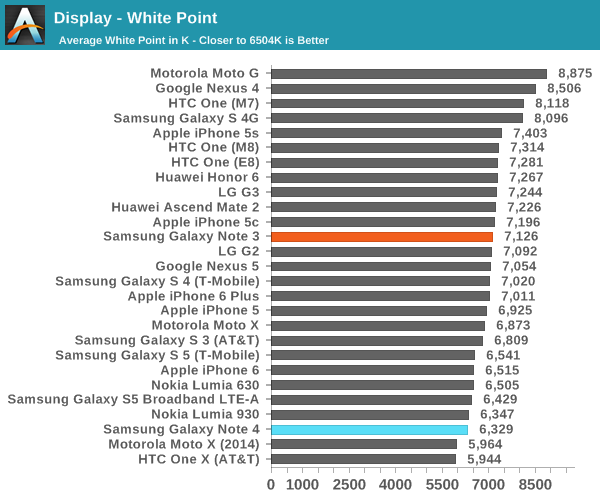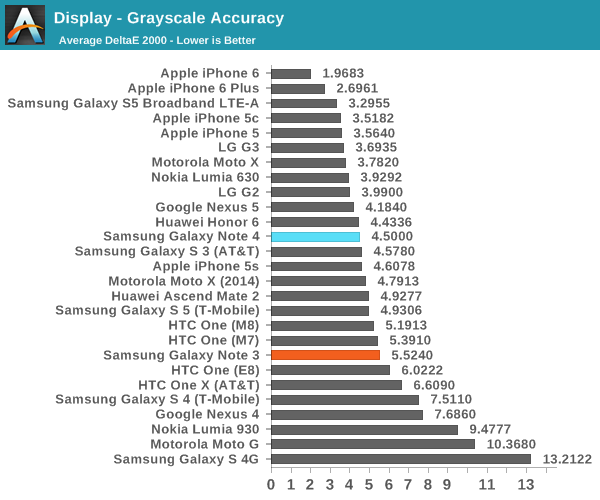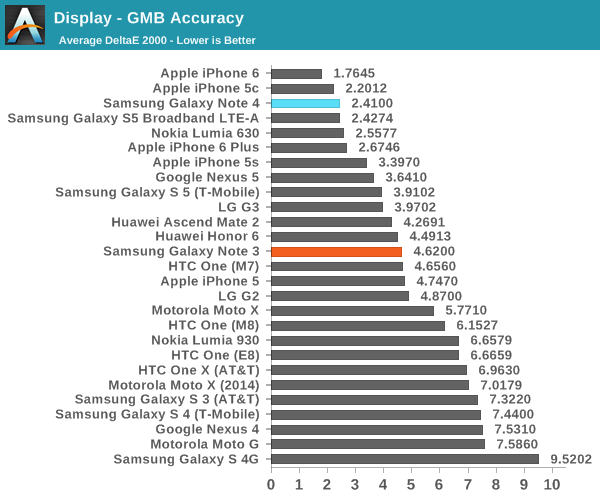The Samsung Galaxy Note 4 Review
by Joshua Ho on October 15, 2014 9:00 AM EST- Posted in
- Smartphones
- Samsung
- Android
- Mobile
- Galaxy Note 4
Display
With the advent of the modern smartphone, the display became one of the most important aspects of the entire experience as it was the only method of interacting with the device. To this end, Samsung has equipped the Galaxy Note 4 with their latest generation AMOLED panel, which has a higher resolution 1440p display, although this is achieved with a PenTile subpixel layout that makes total subpixel density lower than a conventional RGB stripe, so true subpixel density increases around 20% when compared to an RGB stripe 1080p panel. For reference, going from an RGB stripe 1080p panel to a 1440p panel of the same subpixel stripe would have a density increase closer to 80%.
In practice, the visible resolution varies somewhere between the “worst case” where the eye can see the true subpixel density and the best case where the display appears to be an RGB stripe 1440p display. If I look closely it’s still possible to see a fringing patterns in certain cases. Other than these minor cases, the Galaxy Note 4’s display has more than enough resolution for a smartphone use case. This is noticeably better than what I see with the iPhone 6 Plus, although in casual use it’s unlikely that these resolution differences will actually matter in most cases. I definitely think that there will be a visible difference for VR, although even the Galaxy Note 4’s display lacks sufficient resolution to have a “perfect” display in that scenario.
However, resolution is a relatively simple metric to look at. In order to better test the display we must look at other key metrics. In order to do this, we turn to SpectraCal’s CalMAN 5, along with a spectrophotometer for accurate color measurements.

While relatively simple, brightness and contrast are quite important as a display that’s dim or low in contrast will appear to be quite poor. In terms of brightness, we see that Samsung continues to maintain relatively high peak luminance, and a massive improvement when compared to previous generation AMOLED displays. While the normal peak brightness is a bit on the low side, as long as one uses auto-brightness the display’s “boost mode” will be able to activate and reach around 450 nits so in practice sunlight visibility should be more than acceptable. Contrast remains as incredible as it always is with AMOLED displays of this generation, although there still seems to be visible RC delay of some sort as there can be a purple trail effect when pixels transition from an unlit to lit state. I suspect this is mostly unavoidable, and is generally only visible at low brightness.


The next test we’ll look at is grayscale, which can suggest issues with overall tints in the display and issues with gamma. In this area, we see that the display is definitely quite good in overall gamma but unfortunately there’s a bit of a green tint here which causes a regression when compared to the Galaxy S5 LTE-A Broadband. This is really only visible on some certain percentages of gray but it would be an area where some improvement is needed.

While grayscale is one aspect of the display, it’s also important to look at color overall. One of the first tests for color is the saturation sweep, where the Note 4’s display performs admirably. At this point, there’s really not much to point out for improvement as the dE2000 average is low enough that one won’t notice any issues with color accuracy in Basic mode.

Similarly, the display does a fantastic job in the Gretag Macbeth ColorChecker. It should be possible to get a good idea of what a photo will look like on other displays and other similarly color-sensitive work on the Note 4. Samsung has also included other modes for those that want more vivid or otherwise more saturated color, which is of great benefit for those interested in such a color profile. The one potential issue here is that there is color shifting when altering viewing angles. In comparison to the Note 3, the Note 4 has a far better display. As-is, the state of AMOLED seems to be in a dead heat with LCD now as both seem to have their own trade-offs. However, we may soon see a shift as Samsung’s AMOLED becomes indisputably better than even the best LCDs.













195 Comments
View All Comments
Donkey2008 - Wednesday, October 29, 2014 - link
You have to love the 3DMark "onscreen" vs "offscreen" results. As long as any Android doesn't have to actually render images on the screen for the user than it is just as fast as an iPhone. ROLMAO.Announcer97624 - Saturday, November 1, 2014 - link
I don't get the point about battery life trailing behind the IPhone 6 plus? The IPhone 6 plus doesn't have a removable battery so on a 16 hour plane ride the IPhone 6 plus is a liability not an asset compared to the Galaxy Note 4's ability to have a few spare charged batteries. While I have the European Galaxy S5 4G LTE I have a battery wallet with six fresh batteries so I can go for most of a week without charging. My girlfriend has an IPhone 5 and is now going to purchase the Galaxy Note 4 specifically because of the non removable battery on all IPhones.Bikerboy89 - Saturday, November 8, 2014 - link
Wow onscreen GPU performance is laughable. Really bad vs the competition from apple and Nvidia. My LG G Flex gets better onscreen performance in gfxbench and the iPhone 6 gets double or triple Note 4. Pretty pathetic for a flagship device.MattL - Wednesday, November 19, 2014 - link
I finally realize why your color accuracy results differ so much from display mate, where you find the iPhone is more color accurate they found the Note 4 more accurate.http://www.displaymate.com/news.html#Color_Accurac...
"Recently some reviewers have published articles contradicting my Absolute Color Accuracy Measurements for the Samsung Galaxy S5. For example, see this recent review in phone Arena. The problem is that these reviewers are not scientists or display experts, and are using canned display calibration software incorrectly in order to test a display, which produces incorrect results and bogus conclusions. Below is a brief semi-technical analysis...
The Color Difference dE used by the Reviewers Incorrectly includes the Luminance: The reviewers are using retail display calibration software products that use a Color Difference measure called dE, which includes a Luminance (Brightness) Error component in addition to the Color Hue and Saturation (Chromaticity) Error component. Using the Color Difference dE is appropriate for setting the display calibration, but dE is Not a measure of Visual Color Accuracy (Hue and Saturation) because it also includes the Luminance (Brightness). The eye sees and interprets brightness and color as two separate visual issues - dE combines them together. So all conclusions based on using dE for Visual Color Accuracy are incorrect.
Our Color Accuracy only includes Color Hue and Saturation: Since the eye sees color and brightness as two separate visual issues I measure and analyze them separately. My published Absolute Color Accuracy measurements and data analysis includes only the Color (Hue and Saturation) Chromaticity Error component Δ(u'v') or d(u'v'), which evaluates just the difference in Hue and Saturation seen by the eye, and is plotted on a 1976 CIE Uniform Chromaticity Color Diagram in all of my articles. This is the correct method for evaluating Visual Color Accuracy (Hue and Saturation). Compare my very precise and detailed Absolute Color Accuracy plots with their crude figure."
Basically you're doing it wrong anandtech
kamhagh - Monday, May 25, 2015 - link
this phone lags on ui and on games like deadtrigger2, don't trust benchmarks! specially when its samsung..... benchamrks are only meaningless numbers!(well useful in some cases)